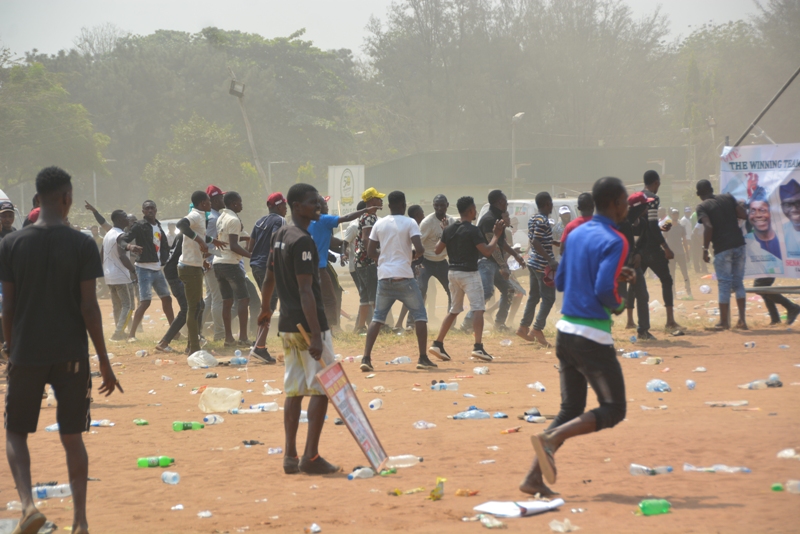“You have to lift a person up before you can really put them in their place”. Chris Jami
Of the many elements that have shaped our existence in the last few weeks, quite a few will remain with us for a long time. There will be a few like SARS, protests, clashes, attacks, lootings, killings, anger and fear that will melt into a future where they will mutate or find expressions in resolutions through changes and reforms. They could also reincarnate in slightly different forms, or worse, in the basic forms we have witnessed them recently. There are also others such as thugs and hoodlums who are etched so deeply into our character as a nation that time alone or tinkering with policies will not remove them from our existence. As we speak, the hoodlum is having the last and loudest say in events covering an amazing month which began without even a hint of his existence. From evidence on the ground, the hoodlum (who is also a thug when he wears attire that hints at politics) will survive, and could even flourish if key lessons are not learnt from the earth-shaking-events that still follow us.
The conventional definition of a hoodlum is a person who engages in crime and violence. In our context, this definition will be considered extremely limiting. We have lived with an increasing scale of violent crimes from the early seventies, and these gave the impetus for the creation of the recently abolished SARS in 1984.Rapidly expanding populations and urban areas, easier access to firearms, compromised law and order institutions, receding influence of social values, shrinking opportunities for social mobility, rising poverty levels and declining qualities of leadership all contributed to a rapid growth of alienated, bitter and dangerous young people who form our widest margin as a society. Governance and the economy focused on an increasingly narrowing circle of citizenry as sources of support or growth. Outside this circle, the amorphous phenomenon that we call the hoodlum grew from infancy as a local nuisance in many communities to the monster that stalks the nation under many guises.
The hoodlum has been many things over the years, in many parts of the country. His basic character as a mobile threat to social order and individual and collective security, breaching the state’s statutory monopoly of the right to the use of violence, living by the day on short term, self-satisfying goals or building lofty goals that are unattainable without breaching the fundamental structures of the Nigerian state is a constant. He was the area boy that harassed locals for a little for drugs and food. He pilfered in the day and robbed with firearms in the night. He broke heads and looted shops in times of numerous conflicts. He was a cultist, pipeline vandal, drug pusher, motor park tout, muscle to ethnic enforcers and majority of our politicians who cannot stand for elections without mobilizing massive violence. He provided the backbone for the ideals of resource control and militancy in the Niger Delta, the periodic enforcement of the Biafran cause and the bulwark of the alienated militants who have sustained the Boko Haram insurgency. He is the bandit that terrorizes communities in the north; the kidnapper who makes fortunes and becomes their slave; the foot soldier in communal conflicts and the gang member who makes forays into cities snatching phones and robbing vehicles in traffic.
The bulk of the hoodlum, however, lives within the community, scraping an existence and keeping an eye on opportunities, virtually all of them illegal. He is located in the distant fringes of society, expecting no favours from the government or his community. He has an intimate knowledge of the police, and he has the scars to show for his numerous encounters with them. The police, in fact, represent the only face of authority he has contact with. He fears the police, but does not respect it or the law and the state it represents. Of all the miscalculations made by the organisers of the #ENDSARS protests, the most serious was not building in the hoodlum into its plans, and ignoring the wider socio-economic contexts of the protests. They raised issues about policing, asking for reforms that could have been accommodated by an administration that was alert and sensitive. Then they raised wider issues about governance that would need a longer period to achieve, assuming, that is, that that they were sincere, and will be content to wait for responses from a lethargic leadership, a cumbersome amendment process built into the constitution and a political system that has been hijacked by a political class that bears a striking similarity with the hoodlum in terms of means and ends. The hoodlum watched, his eyes on immediate goals.
The protests were the perfect setting for the hoodlum to flourish. His poverty has been worsened by the severe damage wrought on the economy by the COVID-19 pandemic. His feelings about leaders and the privileged have primed him for full scale involvement in any activity likely to get him relief for a few days. Unlike the largely middle-class leaders and coordinators of the initial protest, whose disposition gave them the luxury of engaging the state for long periods over ideals and political issues, the hoodlum was more accustomed to a smash-and-grab approach without asking or answering questions. His initial encounter with the protests was in the capacity of the thug, that irritant that the protesters said were unleashed on them by the state or its sympathisers to break its back. The protest had no plans, the time or the expertise to build in the hoodlum into its elaborate, elitist groups, so it fought him back or ran away from him. He followed a crowd that ate well and danced to good music, watching from a healthy distance to snatch a harvest that was being led astray by lack of good strategy and leadership.
The hoodlum was bound to win in a war between a bungling administration and a naive protesting crowd that thought it could have a revolution by tweeting cliches, waving flags and dancing in the streets. Something had to give for him to move in. It did. The back of the protest was broken at Lekki, and it dispersed in many directions. The hoodlum stole its anger and the outrage of much of the nation, and began to attack the state he had always despised and an economy he never believed had a place for him. The state retreated to give space to indignation and because it could not fight the full weight of the hoodlum with policemen and soldiers who were being accused of shooting at unarmed protesters. In a few days, the hoodlum had made a much bigger impact than the protest had done in weeks. Worse, he had smeared the record of the protests with blood and limbs, and had drowned out its appeals and its causes.
When the history of these protests is written, the hoodlum will not challenge it. He is our history. He will always be part of a nation that ignores its margins, that section taken up by the neglected, bitter young who grow into monsters

 Join Daily Trust WhatsApp Community For Quick Access To News and Happenings Around You.
Join Daily Trust WhatsApp Community For Quick Access To News and Happenings Around You.

